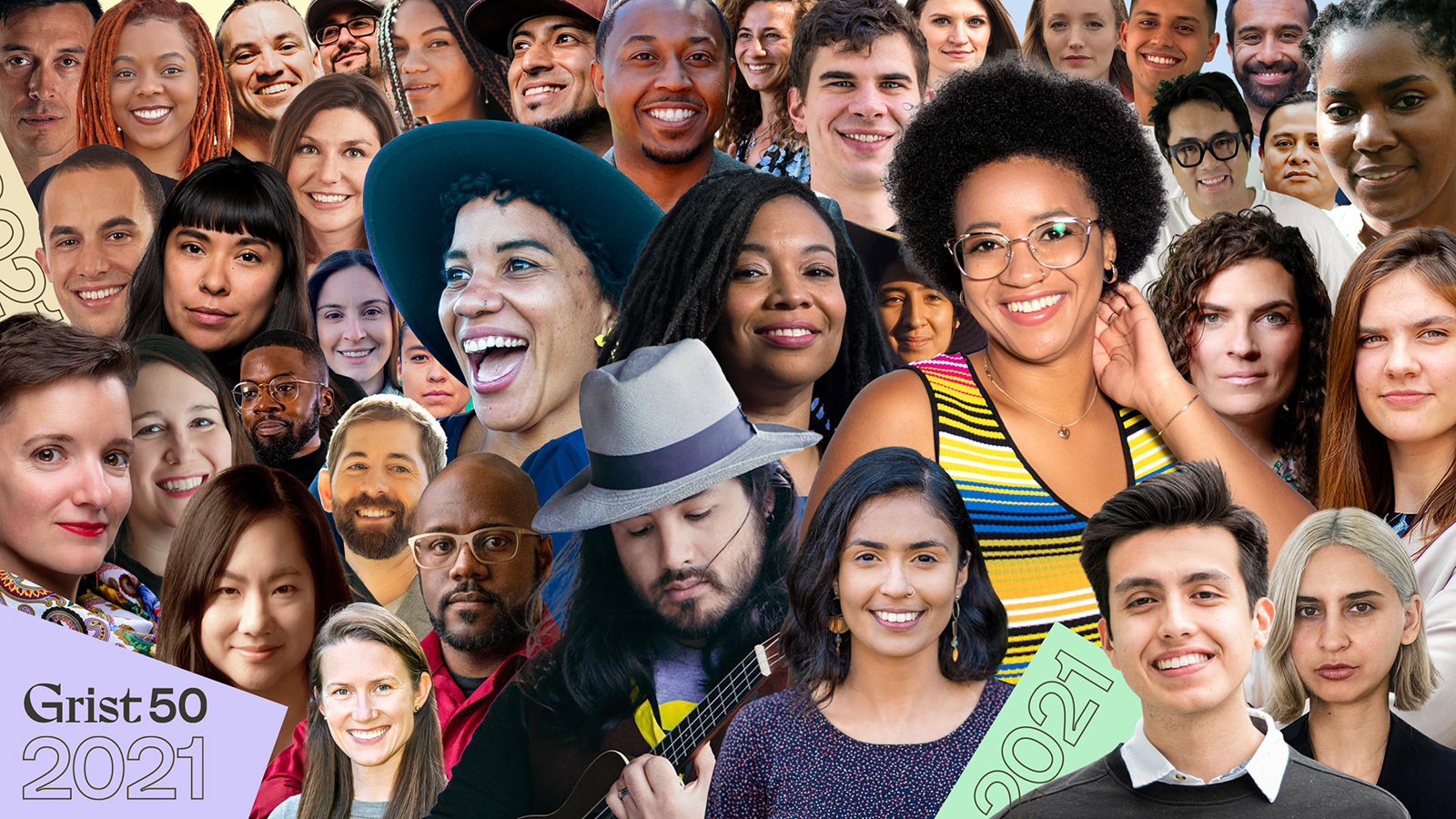My ninth-grade daughter just joined a high school club that is part of a national youth movement to stop climate change and create jobs in the process. You might be thinking the apple doesn’t fall far from the tree. Au contraire. What’s inspired her isn’t ideas from her rapidly graying father, but instead the vision of folks like Sunrise Movement cofounders Varshini Prakash and Evan Weber — two leaders who both happen to have been named to the Grist 50 (before the Green New Deal was even a seedling).
Now, 2022 is approaching, and while a lot of stuff is messed up, I’m holding on to one seed of hope: There’s a remarkable array of people working on solutions to climate change, from new campaign ideas to new forms of art, from transportation innovations to fashion revolutions, and on and on and on. But many of these leaders and their ideas are not yet getting the spotlight they deserve.
That’s why we started the Grist 50 six years ago. And why I’m asking you to nominate someone for the 2022 Grist 50 whose story needs to be told. The Grist 50 is an annual list that shows the world what a vibrant, diverse climate movement looks like. Scientists, activists, entrepreneurs, academics, chefs, storytellers: changemakers of all sorts. (Apples and oranges.)
Do any names spring to mind? Perfect. Suggest them here.
As always, please encourage your friends to subscribe to Shift Happens — and give me a shout with whatever’s on your mind these days.
Chip Giller
Grist Founder & Creative Officer
@cgiller
Your new heroes

For inspiration about whom to nominate, check out these video profiles of five folks on the 2021 Grist 50:
- Gaurab Basu is a primary-care physician who has seen firsthand the impact climate change and fossil-fuel infrastructure has had on his patients, particularly on low-income people of color. As co-director of the Center for Health Equity Education & Advocacy, he lobbies for better policies and better education for medical professionals to treat climate change like the public-health menace it is.
- Cannupa Hanska Luger is a mixed-media artist and member of the Mandan, Hidatsa, Arikara Tribe. His recent work combines sci-fi, performance art, and Indigenous futurisms, under the banner of a project he calls “future ancestral technologies.”
- Amanda LaGrange turns tech waste into jobs. Her company, Tech Dump, employs formerly incarcerated folks to recycle millions of pounds of electronics every year. With the organization’s accompanying retail business, those gadgets can find a new life.
- Earyn McGee is known as the Lizard Lady (or @Afro_Herper on social media). As you might have guessed, McGee’s a herpetologist. She’s also a STEM ambassador, introducing young women of color to careers in science and nature, and making biology fun with games like #FindThatLizard.
- Ceci Pineda keeps food waste out of landfills in America’s biggest city, as the executive director of BK ROT, New York’s first bike-powered composting service. The org employs young people of color from the community as micro-haulers. “We’re a small model compared to the city’s huge footprint,” Pineda says, “but we see ourselves modeling a closed-loop service through which we can responsibly manage our waste.”
Your viewing and listening list

It’s been a good month for conservation. Among other actions, President Biden last week restored Obama-era protections to Bears Ears and Grand Staircase Escalante in Utah, undoingresponding to Donald Trump’s plans to shrink these national monuments drastically.
Trump’s actions represented the largest national monument reduction in history, and prompted outcry from outdoor advocates and Indigenous groups. Fixer Faith E. Briggs, a runner and filmmaker, pushed back against the Trump administration by producing a short film, This Land, documenting a 150-mile run from Utah to New Mexico through areas that were at risk. The film combines stunning scenery with reflections on the importance of public lands, and on the interplay of race, conservation, and equity. Lucky for you, you can watch the 10-minute doc for free here. And check out the accompanying podcast Briggs hosts with fellow athlete and advocate Addie Thompson, The Trail Ahead.
Your pick-me-up
- Forward motion. Later this month, the Fix team is launching a new, hope-filled newsletter, Looking Forward. Subscribe now so you don’t miss the first edition; every other Thursday, the team will bring you glimpses of a clean, green, just future.
- Windows to the future? In a first-of-its-kind victory for the right-to-repair movement, Microsoft has agreed to take steps to facilitate the independent repair of its devices following pressure from its shareholders. It’s a first early step for the movement whose leaders include Fixer Nathan Proctor and which was explored in depth in a recent Trevor Noah segment on The Daily Show.
- A Swedish minute. Paris and other urban hubs are pursuing the vision of “15-minute cities,” in which people can get their daily needs met with a short walk or bike ride. Now, in a national initiative, Sweden is layering on the idea of a “one-minute city,” viewing each city block as a space to connect communities, rather than simply to shuffle and store cars.
- It isn’t easy being … oh, you know. A dozen years ago, Vancouver, British Columbia, set out to be the greenest city in the world. What followed is a cautionary tale — big successes (bike lanes! more public transit! more parks!) and failures (for starters, it’s dang hard to cut emissions from existing buildings) — with lots of lessons for other cities working to claim the title.
- Time to plug in. Twitter is all agog about electric-vehicle sales in China — 17 percent of all cars sold last month — while sales of internal-combustion-engine cars slip. David Roberts has a related interview with Kingsmill Bond of the think tank Carbon Tracker, who is markedly optimistic about the pace of the shift to clean energy — and who says “China will bury the U.S.” if our country doesn’t meet the Biden administration’s goal of becoming 100-percent carbon-free by 2035.
- Fungi on the run … way. “In fashion, mushrooms are the future,” mycologist Paul Stamets declared in a soundtrack that opened Stella McCartney’s new collection at Fashion Week in Paris. Like others, McCartney is touting the potential of substitute leather made from mycelium. The company that produces it, Bolt Threads, is headed by Fixer Dan Widmaier.
Your weekend plan
My grandmother Elsie was a crazy-good baker. But maybe the thing I loved best from her kitchen was her applesauce. It was just the right consistency (not runny!) and had just the right taste (not too sweet — even a touch of tartness). We’ve been making loads of applesauce in our house in honor of her this fall, with apples collected from around the neighborhood.
Steps to splendid applesauce:
- Cut 3 lbs of good sauce apples into quarters, ideally using at least three varieties — e.g., McIntosh, Cortland, Braeburn.
- Place into a cooking pot, and add 1/3 cup cider or water.
- Cover and cook at medium-low temperature, stirring occasionally, for about 35 minutes, until soft.
- Uncover pot and let cool for a moment or two.
- Process using a food mill with a medium-sized grate to catch seeds and skins. (If you don’t have a food mill, peel and seed the apples before cooking, and then use a food processor or immersion blender to mix and mash up the softened apples. But the cooked skins do lend a beautiful color to the sauce.)
- Add lemon juice to taste, with a bit of honey and cinnamon (be sure not to overdo it). That’s it!
And while you’re enjoying this seasonal treat, grab your phone and make some Calls 4 Climate.



